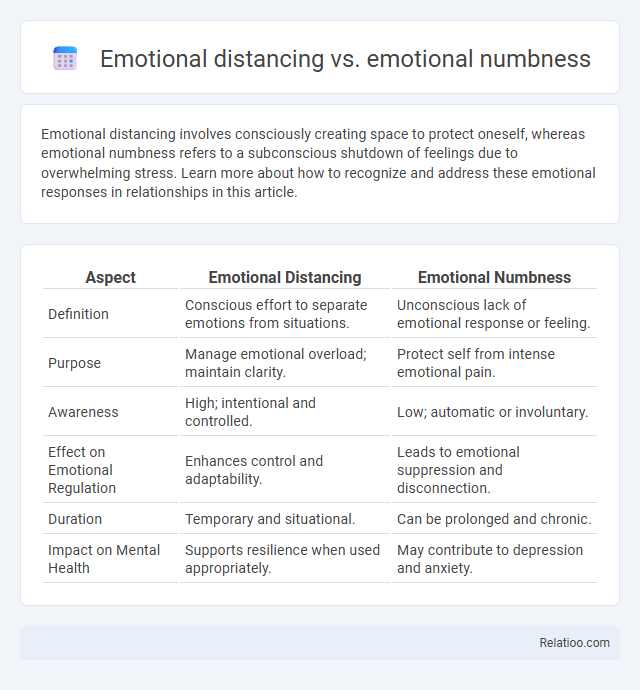Emotional distancing involves consciously creating space to protect oneself, whereas emotional numbness refers to a subconscious shutdown of feelings due to overwhelming stress. Learn more about how to recognize and address these emotional responses in relationships in this article.
Table of Comparison
| Aspect | Emotional Distancing | Emotional Numbness |
|---|---|---|
| Definition | Conscious effort to separate emotions from situations. | Unconscious lack of emotional response or feeling. |
| Purpose | Manage emotional overload; maintain clarity. | Protect self from intense emotional pain. |
| Awareness | High; intentional and controlled. | Low; automatic or involuntary. |
| Effect on Emotional Regulation | Enhances control and adaptability. | Leads to emotional suppression and disconnection. |
| Duration | Temporary and situational. | Can be prolonged and chronic. |
| Impact on Mental Health | Supports resilience when used appropriately. | May contribute to depression and anxiety. |
Understanding Emotional Distancing
Understanding emotional distancing involves recognizing it as a psychological strategy where individuals create space between themselves and their feelings to protect against emotional pain or overwhelm. Emotional distancing differs from emotional numbness, which is characterized by an absence or suppression of feelings, often linked to trauma or depression. While emotional distancing is a conscious or semi-conscious choice to manage stress, emotional numbness represents a deeper disconnection from emotional experiences, impacting mental health and interpersonal relationships.
Defining Emotional Numbness
Emotional numbness refers to a state where individuals experience a significant reduction or absence of emotional responsiveness, often as a defense mechanism against overwhelming stress or trauma. Unlike emotional distancing, which involves deliberately creating psychological space from feelings to maintain control, emotional numbness is characterized by a pervasive sense of detachment and inability to feel emotions, impacting daily functioning. This condition is commonly observed in mental health disorders such as depression, PTSD, and anxiety, where the brain's emotional processing is disrupted.
Key Differences Between Emotional Distancing and Numbness
Emotional distancing involves consciously or unconsciously creating space between yourself and your emotions or others to protect from pain, whereas emotional numbness is a state of diminished emotional responsiveness where feelings are blunted or absent altogether. Emotional distancing allows some level of emotional engagement but with controlled boundaries, while emotional numbness results in a lack of emotional connection and often feels like emotional shutdown. Understanding these key differences helps you recognize whether you are avoiding feelings purposefully or experiencing a deeper emotional disconnection that may require support.
Causes of Emotional Distancing
Emotional distancing often arises from fear of vulnerability, past trauma, or prolonged stress, leading individuals to create protective barriers to avoid pain. Unlike emotional numbness, which involves a shutdown of feelings due to overwhelming emotional overload or depression, emotional distancing is a deliberate coping mechanism to maintain control. Causes of emotional distancing include unresolved conflicts, attachment issues, and fear of rejection or intimacy.
Root Causes of Emotional Numbness
Emotional numbness often stems from prolonged exposure to stress, trauma, or unresolved psychological pain, causing your brain to suppress feelings as a protective mechanism. Unlike emotional distancing, which involves consciously or unconsciously creating space between yourself and your emotions, numbness blocks emotional sensation altogether, making it difficult to connect with your own feelings or others. Understanding these root causes can help you recognize when numbness is masking deeper issues that require attention and care.
Psychological Impact on Relationships
Emotional distancing involves consciously creating space to protect oneself, often leading to reduced intimacy and communication in relationships, while emotional numbness results from overwhelming stress or trauma, causing a lack of emotional responsiveness that hinders empathy and connection. Both states contribute to relationship strain by impairing emotional availability and trust, yet emotional distancing is more deliberate, whereas numbness is an involuntary psychological defense. Understanding these distinctions is crucial for addressing the psychological impact on relationship dynamics and fostering emotional healing.
Signs and Symptoms to Watch For
Emotional distancing involves consciously creating space from feelings to protect your well-being, often signaled by withdrawal from social interactions and reduced emotional expression. Emotional numbness is marked by an overwhelming lack of feeling or response to events, with signs including difficulty connecting emotionally, a sense of detachment, and impaired ability to experience pleasure. To identify whether you are experiencing emotional distancing or numbness, watch for symptoms like diminished empathy, reluctance to share feelings, persistent fatigue, or an inability to react to normally engaging situations.
Coping Strategies for Emotional Distancing
Emotional distancing involves consciously creating space from feelings to maintain clarity, distinct from emotional numbness where one is unable to feel due to suppression or trauma. Effective coping strategies for emotional distancing include practicing mindfulness to stay present, setting boundaries to protect emotional energy, and using cognitive reframing to manage stress without becoming detached. Developing emotional awareness and seeking supportive relationships also help balance distance with empathy, preventing isolation while maintaining self-protection.
Healing from Emotional Numbness
Emotional distancing creates space to protect your feelings, while emotional numbness blocks emotional response altogether, often stemming from trauma or prolonged stress. Healing from emotional numbness requires self-awareness, therapy, and gradual reconnection with suppressed feelings to restore emotional balance. Your journey toward healing involves recognizing these patterns and fostering emotional resilience through mindful practices and support.
Seeking Professional Support and Therapy
Emotional distancing involves consciously setting boundaries to protect mental health, while emotional numbness refers to an involuntary shutdown of feelings often linked to trauma or depression. Seeking professional support through therapy can help individuals differentiate between these experiences and develop healthy coping mechanisms. Therapeutic interventions such as cognitive-behavioral therapy (CBT) and trauma-focused therapy provide tools for re-engaging with emotions and improving emotional regulation.

Infographic: Emotional distancing vs Emotional numbness
 relatioo.com
relatioo.com